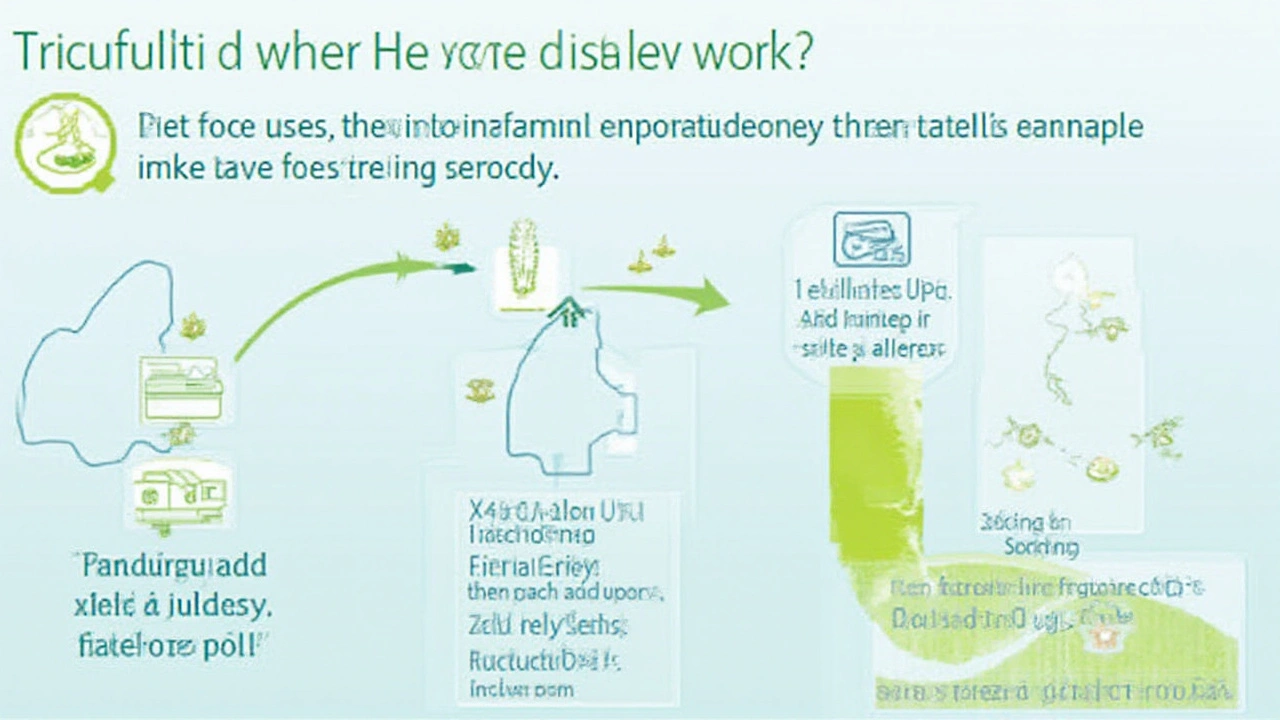If you’ve ever felt your nose suddenly stuffy, your eyes watery, and your throat scratchy just when your day was about to get good, you know the quiet misery of allergies. Now, there’s a good chance you’ve seen Xyzal on the pharmacy shelf, probably with a bright label promising relief by morning. But what’s actually in that little tablet, and is it really worth swapping your box of tissues for?
What Is Xyzal and How Does It Work?
Xyzal, or levocetirizine dihydrochloride if you're into tongue twisters, falls squarely into the world of second-generation antihistamines. That's science's way of saying it's meant to hit your allergy symptoms without completely zapping your energy like older antihistamines did. It works by blocking histamine, a natural substance your body releases during an allergic reaction. Histamine is behind itchy eyes, sneezing, runny noses, and that itching that seems to come from nowhere. By attaching to histamine receptors, Xyzal stops those signals, aiming to free you from your typical allergy misery.
Now, here’s something people miss: Xyzal uses only the active "left-handed" part of the cetirizine molecule (a little chemistry trick called chirality), so it’s designed to do the job with fewer drowsy side effects. This edge is more than just marketing—clinical studies have shown it starts working in about an hour, sometimes less, and can provide up to 24 hours of relief with just one dose. That’s a huge step up if you hate mid-day dosing or forget to take your meds until you're already sneezing.
Unlike some older rivals, Xyzal is less likely to cross into your brain and knock you out. So, many users report fewer “fuzzy head” moments. Note, though, that less likely doesn’t mean zero chance—everyone’s body is a wild card. If you’re sensitive to medicines or prone to drowsiness, be ready for some trial and error, especially the first time you use it.
Doctors usually recommend it for sneezing, nasal congestion, itchy watery eyes, and chronic hives—basically, the allergy “greatest hits.” Xyzal can be taken at night (that’s the common advice), so if a rare wave of sleepiness hits you, it does so when you’re already winding down. Plus, nighttime use means you wake up with symptom relief instead of waking up mid-sneeze.
Who Should Consider Taking Xyzal?
This antihistamine walks a thin line—strong enough to help, but gentle enough for most people. Xyzal is FDA-approved for adults and kids as young as six months (with specific doses). It’s a front-runner if you have seasonal allergies, perennial indoor allergies (think dust mites or pet dander), or if you experience chronic urticaria (that’s doctor-speak for persistent hives). If you constantly battle morning congestion or need relief throughout your day at work, Xyzal’s 24-hour window is a game changer.
You need to know your body, though. If you’ve had weird reactions to other antihistamines, or you have kidney problems, caution is key. Xyzal is cleared by your kidneys, not your liver, which matters if you have impaired kidney function. For older adults, or anyone with pre-existing kidney issues, your doctor might suggest a lower dose or a different allergy med entirely. There’s also a slight risk of drowsiness even with the newer generation, so don’t plan to hit the road or operate heavy machinery when you first try it.
If you’re pregnant or breastfeeding, the official advice is to check with your doctor before popping Xyzal. While no major fetal harm has been observed, no allergy pill is tested for every possible scenario. Plus, Xyzal has not been found in harmful levels in breast milk, but consult anyway—better safe than sorry when there’s a little one involved.
Sometimes, folks with severe allergies take Xyzal alongside other allergy control methods, like nasal sprays or allergy shots, especially during major pollen spikes. That stacking can make those rough seasons much more tolerable, but you shouldn’t double up on similar antihistamines without a doctor’s green light.

Benefits and Drawbacks: What Science Actually Says
Promise-filled commercials aside, Xyzal’s biggest endorsement comes from studies comparing it to both placebo and other antihistamines. It consistently outperforms sugar pills and offers equivalent or slightly better relief than similar second-generation antihistamines like Zyrtec (certirizine) and Claritin (loratadine). The difference? Many users say Xyzal feels a little “cleaner,” with a lower chance of unwanted sedation, especially when compared to the older ones you might remember from the early 2000s.
Let’s talk about actual numbers. Trials with adult patients suffering from seasonal allergies found that around 60-70% reported significant symptom lowering within the first week. For chronic hive sufferers, most saw reduced itching and fewer outbreaks with steady use. In kids, it’s shown safety and effectiveness for ages two and up (with doctor guidance for the younger group).
The flip side? No allergy drug is without its baggage. Some people still get a dry mouth, a little drowsiness, or headaches. Rare users reported irritability or stomach pain. And, while second-generation antihistamines like Xyzal are considered “non-drowsy,” a percentage of people still notice sleepiness—if this is you, definitely try taking it before bed.
An unexpected benefit you might not have guessed: because Xyzal can help you breathe and sleep better at night, it may boost alertness the next day for allergy sufferers who usually struggle with sleep debt. In one sleep lab study, adults who took Xyzal reported fewer nighttime wake-ups and scored better on morning alertness tests compared to those who just gritted their teeth through allergy season.
This all sounds great, right? But here’s the kicker—overusing or doubling up your dose won’t “supercharge” your relief. The body can only use so much antihistamine at a time. Taking too much just ups your risk of side effects without extra benefit.
Tips for Getting the Most from Your Xyzal
A lot of people grab an allergy pill when they’re already in the throes of symptoms, but Xyzal is all about timing. Start it before your symptoms explode—when you know allergy season is coming, or before you visit the home of that fluffy friend. The medication works best when it blocks the histamine surge at the source, not after your nose has become Niagara Falls.
- Take one tablet (or the dose for your age/weight) once daily, preferably in the evening. Doing so minimizes any drowsiness while letting the benefits kick in by the morning.
- Be consistent. Don’t skip days and jump back in, as steady bloodstream levels control knocking out those pesky symptoms.
- If you forget a dose, don’t double up the next day. Just get back on your usual schedule. Doubling leads to headaches and possibly more drowsiness.
- Try to pair Xyzal use with some basic allergy-proofing—think air purifiers, keeping windows shut during high pollen times, and regular washing of bedding.
- Remember, if you’re adding other medications, check for interactions. While Xyzal typically plays well with most meds, certain sleeping pills, anti-anxiety drugs, or alcohol can amplify side effects.
If you have mild kidney impairment, ask your doctor for a smaller dose or take it less often. Always read the package label—even if you’ve used Xyzal before, formulas can change and you want to stay current on warnings.
Here’s a practical tip: track your allergy symptoms on your calendar or with an app. You’ll see if Xyzal is matching up with your worst days and if it really works for your specific triggers. What works for pollen in spring might be different than dust in the fall, so adjust your approach as needed.

Handling Xyzal Side Effects and When to See a Doctor
Thankfully, most folks using Xyzal never hit a major snag. If you do get mild side effects, like dry mouth or sleepiness, these tend to ease up after your body gets used to the new routine—usually within a few days. Drinking water, keeping caffeinated drinks to a minimum, and using sugar-free lozenges can make things easier if dry mouth bugs you.
If your job or routine is sensitive to drowsiness—driving, operating machinery, or high-focus work—try your first dose on a low-stakes day, maybe a weekend or evening. If you feel totally fine, you’re probably in the clear. But don’t be surprised if you’re among the small group who feel more tired; it’s all in how your system processes the antihistamine.
The people most at risk for more serious problems are kids, seniors, or those with kidney disease. Watch for confusion, fast heartbeats, unusual irritability or any sign of an allergic reaction (ironically), like swelling or serious rashes. Don’t tough it out—get medical help if you experience chest pain, severe dizziness, or trouble breathing.
Long-term use? No evidence connects Xyzal to dependency or tolerance. But if you find yourself needing allergy medicine most of the year, stop and take stock. Chronic allergies could need a bigger plan, like immunotherapy or targeted prescription drugs. A good allergist can help you cut through guesswork and get to real, lasting relief.
All said, Xyzal is one of the go-to tools for fighting the misery of sneezing, sniffling, and itching year-round. Xyzal is easily found over the counter, but like all allergy meds, using it smartly makes all the difference.

Hardik Malhan
July 12, 2025 AT 02:17Xyzal is levocetirizine dihydrochloride a chiral selective H1 antagonist with high receptor affinity and minimal CNS penetration compared to racemic cetirizine
Pharmacokinetics show renal clearance dominates with t1/2 ~8h in healthy adults
Effective dose 5mg QD for allergic rhinitis and chronic urticaria
Key advantage over loratadine is faster onset and sustained 24h control
Not metabolized by CYP450 so fewer drug interactions
But watch out in CKD patients-dose adjustment needed for eGFR <30
Also avoid concurrent CNS depressants even if labeled non-sedating
Studies show 68% symptom reduction vs placebo at week 1
Real world adherence is better than Zyrtec because people don’t feel zombie-ed
Casey Nicole
July 12, 2025 AT 18:25Ugh I can’t believe people still take this garbage when you can just move to a country that doesn’t have pollen
Also why are we even talking about this like it’s some miracle drug
It’s just a fancy antihistamine
And don’t even get me started on how Americans treat every sniffle like a medical emergency
We had a guy in my office take 3 doses in one day because he thought it would make him ‘super immune’
Pathetic
Kelsey Worth
July 13, 2025 AT 17:47so i took xyzal for the first time last week and i swear it felt like my brain finally stopped being wrapped in cotton
also i accidentally took it in the morning and i was fine??
like maybe the whole 'take it at night' thing is just a myth??
also i spelled xyzal wrong like 5 times in this comment but you get the point
also my cat is now allergic to my meds so we’re all suffering together
shelly roche
July 13, 2025 AT 22:32Y’all need to hear this: Xyzal changed my life
I used to be the person who cried in the grocery store because my eyes were watering
Now I can go outside without a hat and sunglasses and a mask
It’s not magic, it’s science
And if you’re worried about drowsiness, try it on a Friday night
Let your body adjust
Also pair it with a HEPA filter and wash your sheets weekly
It’s not just the pill-it’s the whole system
You got this
And if you’re a parent of a kid with allergies? You’re doing amazing
Keep going
Nirmal Jaysval
July 15, 2025 AT 07:20lol people act like xyzal is the holy grail
my uncle took it and still sneezed like a chainsaw
also why are you all so obsessed with this one pill
just stay inside and drink tea
and if you got kidney probs dont take it dumbass
learn to read the label
also i think it’s overpriced
why not just take benadryl and sleep it off
Emily Rose
July 16, 2025 AT 20:10Hardik you’re 100% right about the renal clearance
But I’ve seen so many patients with mild CKD get prescribed full doses because the doctor didn’t check eGFR
It’s a silent danger
And Kelsey-yes, taking it in the morning works for some of us
My body just doesn’t respond to the nighttime myth
Emily Nesbit, I agree with you about the lack of long-term safety data
But for chronic sufferers? It’s still the least bad option
Let’s stop shaming people for using medication to live normally
Also-air purifiers are non-negotiable
And if you’re in India, dust mites are worse than pollen
Wash your curtains
Benedict Dy
July 16, 2025 AT 23:22There is a fundamental flaw in the public perception of Xyzal as a ‘non-sedating’ agent
Pharmacologically, it is correct to state that its CNS penetration is lower than first-generation antihistamines
However, the term ‘non-sedating’ is a regulatory misnomer
Individual variability in blood-brain barrier permeability, CYP2D6 metabolism, and baseline histamine receptor sensitivity renders this label misleading
Moreover, the clinical trials relied on subjective fatigue scales
Objective psychomotor testing shows measurable impairment in 12% of users
Marketing has weaponized the word ‘gentle’
This is not a benign compound
It is a receptor antagonist with systemic effects
And the normalization of daily antihistamine use reflects a societal failure to address environmental allergen loads
Emily Nesbit
July 17, 2025 AT 04:43Benedict is technically correct, but also missing the point
Yes, Xyzal has pharmacological limitations
But for the 70% of people who actually get relief without side effects, it’s a gift
Not everyone has the luxury of living in a sterile bubble or seeing an allergist every month
Over-the-counter access saves lives
And yes, the word ‘non-sedating’ is misleading
But so is calling it ‘dangerous’
It’s a tool
Use it wisely
Don’t overuse it
And stop pretending everyone should just ‘tough it out’
John Power
July 17, 2025 AT 10:07Emily, you’re so right
I used to think I was just ‘bad with allergies’
Turns out I just needed the right med + air filter + no carpet
My kid used to wake up coughing every morning
Now she sleeps through the night
And I’m not saying Xyzal is perfect
But it’s the first thing that actually worked
And if you’re reading this and you’re scared to try it
Start low
Take it at night
Give it a week
You might be surprised
And if it doesn’t work? That’s okay too
There are other options
You’re not broken
You’re just allergic